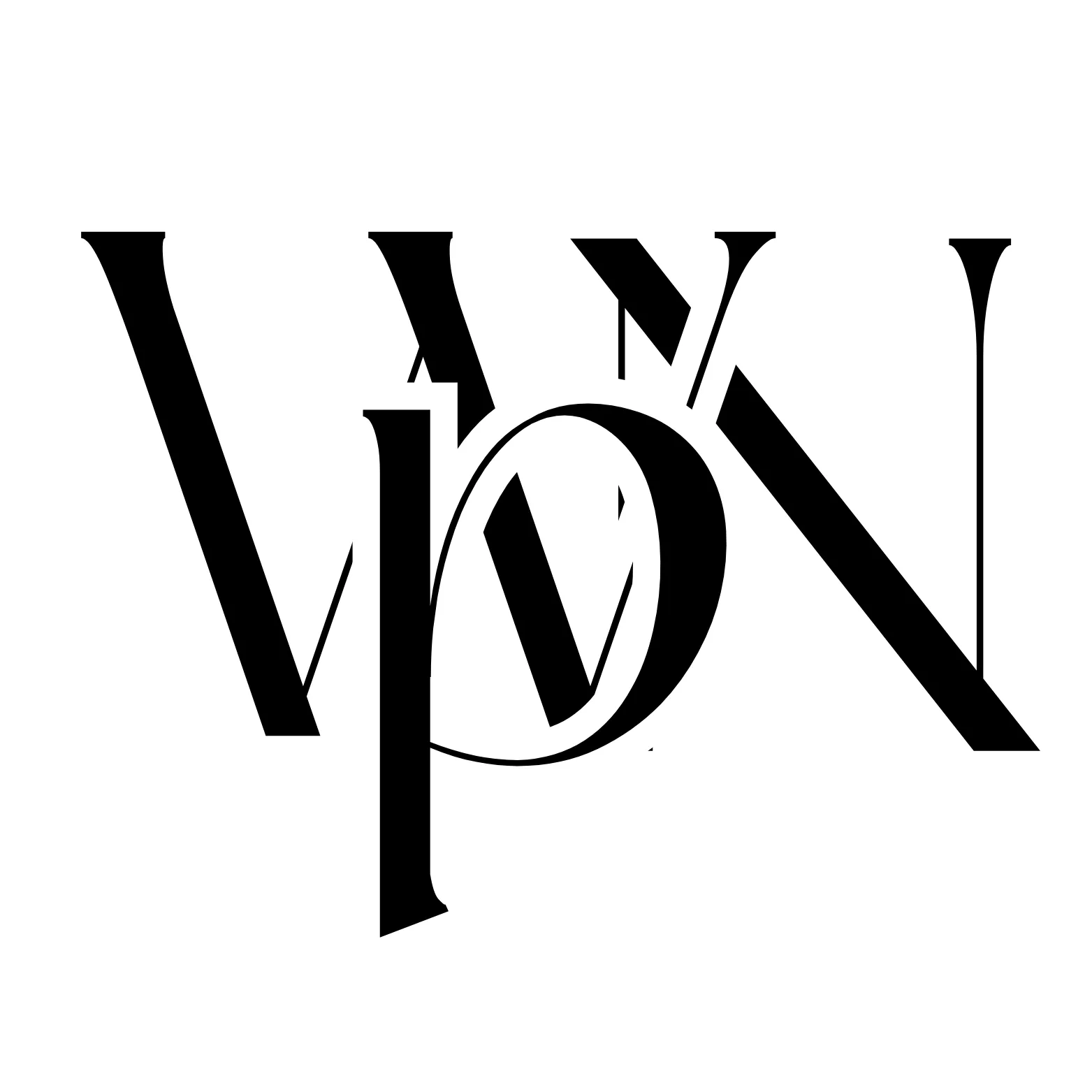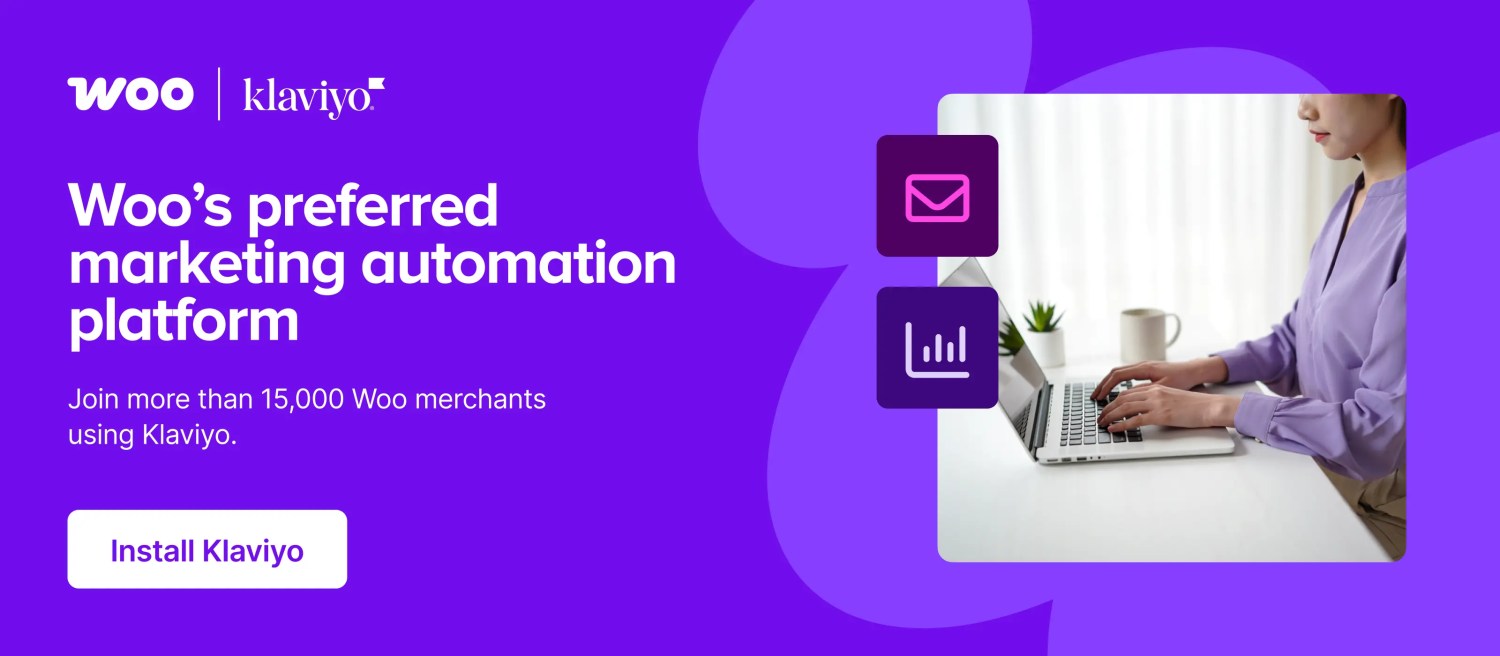You have a great online store, sparkling product photos and descriptions, a seamless checkout process, and a strong user experience. But if you’re still looking for ways to generate more revenue, creating a newsletter is an excellent solution.
In fact, creating your very own email newsletter may be the single most important foundational element of your marketing mix.
Yes, more important than social media accounts, videos, and influencers. Creating and sending out a consistent newsletter does more for your business than all those things, and we’ll talk about why in this article.
You’ll also learn how to create a newsletter on a regular basis that your subscribers appreciate — even if you’re not a designer. We’ll discuss how to get ideas, and how to turn an ecommerce newsletter into that steady stream of revenue you’ve always wanted.
What makes a newsletter different from all other forms of marketing?
The key difference is, you’re sending it to people who’ve agreed to receive it. They asked to hear from your business. They either joined your email list directly from your ecommerce website, or they agreed to receive emails from you by checking a box when they made a purchase.

That sets these people apart from everyone who sees all your other marketing strategies, including social posts and ads, search ads, and all your other digital marketing campaign efforts. All that stuff is trying to get people’s attention who may or may not have any idea who you are, or have any interest in or need for your products.
But the people on your email list chose to be there. This is a warmer, more receptive audience. These are your existing customers, fans, and subscribers. These people are your repeat buyers, loyal customers, and fans.
So your ecommerce newsletter isn’t being sent to strangers. They know your brand. And that gives you a whole new list of reasons to send your newsletter. Here are the main ones:
To stay top of mind and be memorable
This is first on the list because it’s the main reason to send an ecommerce newsletter.
It’s a crowded marketplace. We’re bombarded with advertising and marketing. We’re yanked around by smartphones and shiny objects. Getting and keeping attention is very difficult in the digital age.
Your newsletter is your single best form of media to continually reach out and engage with people who have signaled interest in hearing from you. It goes straight to their inbox.
No one sees all your social media posts. Sending print is much more expensive so you can’t do it nearly as often. But email goes right to them. All they have to do is open it. And even if they don’t open it, they still see your subject line, which acts as its own message and keeps you on their mind.
Your emails sustain the connection between your ecommerce business and your existing customers and subscribers.
They’ll remember your brand, and they’ll think of your products when making their next buying decision.
If you don’t send email newsletters, you’ll risk a large percentage of people who expressed interest in your brand forgetting about it.
Your subscribers will become your best and most loyal customers if you continue to nurture a relationship with them.
To be relevant
An ecommerce newsletter is most effective when it’s relevant to the lives of your customers and subscribers. And to be clear — all subscribers who haven’t yet made a purchase are potential customers. Keep sending them relevant and valuable content through email, and many of them will eventually make a purchase.
What is relevance?
Any content that matters to the lives of its readers. Not all your content has to be about your products and services. It could include trends, seasonal tips, or cultural references aligned with your target audience’s interests.
Later in this post, we’ll share more examples and cover how to use audience segmentation to your advantage.
To be helpful
Related to relevance is helpfulness. Good ecommerce newsletters solve problems. They answer questions, give good advice, address needs, and make life easier.
If you can help your subscribers save time, reduce stress, and have an enjoyable online experience, they will reward you by continuing to engage and buy.
To offer solutions
This one is worth emphasizing. Whatever solutions you can provide that relate to your niche, an ecommerce newsletter is a great way to deliver them.
For example, suppose you sell health supplements.
What challenges and problems does your target audience face?
They could deal with things as varied as arthritis, muscle and joint pain, energy and alertness, mental clarity, flexibility, and stress. Beyond just your products, you can offer solutions to these problems in your email newsletter.
DOMMA, a Woo store based in Spain, did just that. By creating a community for education on the main challenges of their target audience, they were able to grow their business quickly and maintain a loyal following.
Look at your products and services. Consider the challenges your target market deals with. What keeps them up at night? What do they think about, worry about, and care about?
Your ecommerce newsletter can talk about these things and offer answers. And sometimes — but not always — those answers will be your products.
To entertain
For a D2C business, this is probably the most overlooked aspect of great ecommerce newsletters. Hardly anyone does this well, consistently. But you can stand out in the crowd if you succeed at this. What do you have to do? It’s simple:
Be fun!
Inject some humor when you create your newsletter. Use funny quotes, memes, GIFs, and silly videos. Share funny stories. Show your personality. Reference pop culture. Use real life to make people laugh.
Humor, entertainment, and personality make a newsletter memorable. You’re giving readers a reason to open your emails other than being sold to, and other than having to think about their problems. Sometimes you can just make them laugh. And the relational capital you earn from that can sustain their email subscription for months, if not years.
To be relatable
The best ecommerce newsletters position you as a friend, rather than a corporation trying to check off all the boxes.
Use common language, not polished prose that reads like it was edited and approved by sixteen committees.
Especially, be careful when using AI to write your newsletters. AI writing can produce content fast, but its greatest shortcoming is the lack of personality and humanity. While generative AI models are improving, their content still tends to be dry, bland, and easily identifiable. If you do want to use AI to help write your newsletters, you must be sure to edit and improve whatever the AI generates, and infuse it with relatable, human personality and language.
To reach specific audience segments
This is one of your best reasons to create a newsletter.
Consider the earlier example of the supplement ecommerce store. A large supplement brand has customers ranging in age, race, location, athletic and physical ability, lifestyle status, and so many other demographics.
With a newsletter, you can segment your general subscriber list into specialized groups and then use those groups to ramp up the relevance of your email marketing. How? By sharing content and products that appeal specifically to each group.
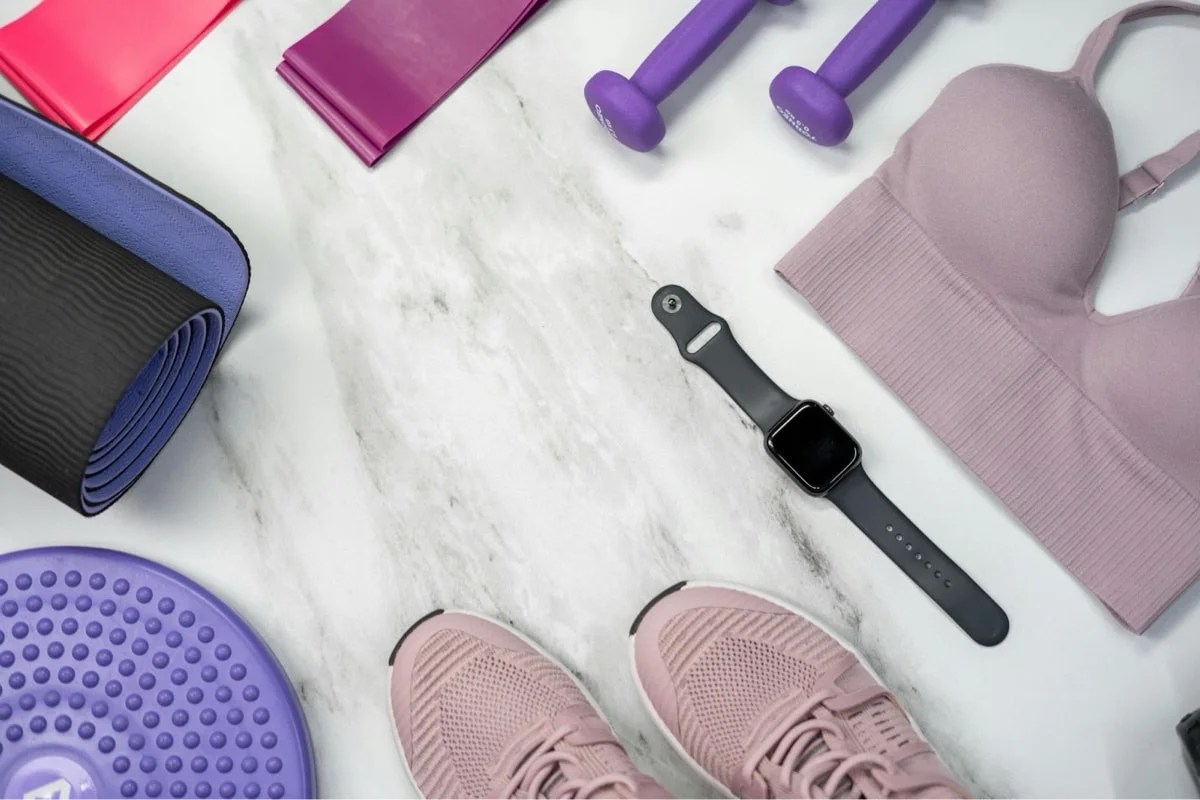
Suppose the health supplement store sends a newsletter. One article is about staying active in retirement. Another item is a poll about what you eat before a workout. The last item talks about natural remedies for pain.
Each of those sections speaks to a different type of person. Your retirees will self-identify by clicking on the first link. Your fitness and workout subscribers will take the poll. Your subscribers who are dealing with pain and who prefer natural remedies will click the third.
You can set up your email marketing platform to funnel everyone who clicks on each link into distinct segments. Now you’ll have a retiree segment, a fitness segment, and a natural remedies segment.
From that point, you can create content about retirees, but send it only to that segment. You’re now achieving hyper-relevance, and you can go into much greater depth about retiree health and lifestyle issues, and your retiree subscribers will love it, because it speaks to them.
Segmentation takes time, and it’s hard to do if all you’re ever sending out is sales emails.
With a consistent email newsletter, especially ones that touch on multiple topics, you can much more quickly break up your subscriber list into more defined market segments. And from there, you can dramatically increase the relevance of your emails.
Last, but not least: To sell
We haven’t forgotten that the primary objective of an ecommerce newsletter is to increase revenue. Make sales and product promotions a regular part of your newsletter. Don’t be shy about it. You’re a business. Your subscribers know this, and they’re fine with it.
You should be regularly presenting products with appealing offers and deals that reward them for being on your email list.
Use special coupon codes so you can trace revenue to your ecommerce newsletter. Offer deals no one else gets. Introduce new products and let your subscribers be the first to buy. And if you can segment your list effectively, you can cater your promotions and sales offers to each segment, and gain much higher response and conversion rates.
As you grow and monetize your email list, here’s the fun part — ecommerce newsletter ideas for what to include in your content.
New product announcements
No one will see every email related to a new product, but most of your subscribers will see at least one or a handful of them — if you send out enough emails.
It’s not every day you launch a new product or offer a new experience in your ecommerce store.
So when you do, promote it. A lot. Think of all the topics you can cover in the weeks leading up to when a new product gets released:
- Vague, curiosity-inducing announcement of something big coming — but no details
- Benefits of the new product teased without naming the product
- New product name and packaging
- The story behind the new product — how it was made, who created it
- Unique features
- Various benefits — how it helps
- Comparisons to other products
- Exact date and time it will be released
- Special deals only available to email subscribers, with deadlines
- Photos and videos
You could probably think of more. But in looking at that list, you now have ten ideas that each merit their own email.
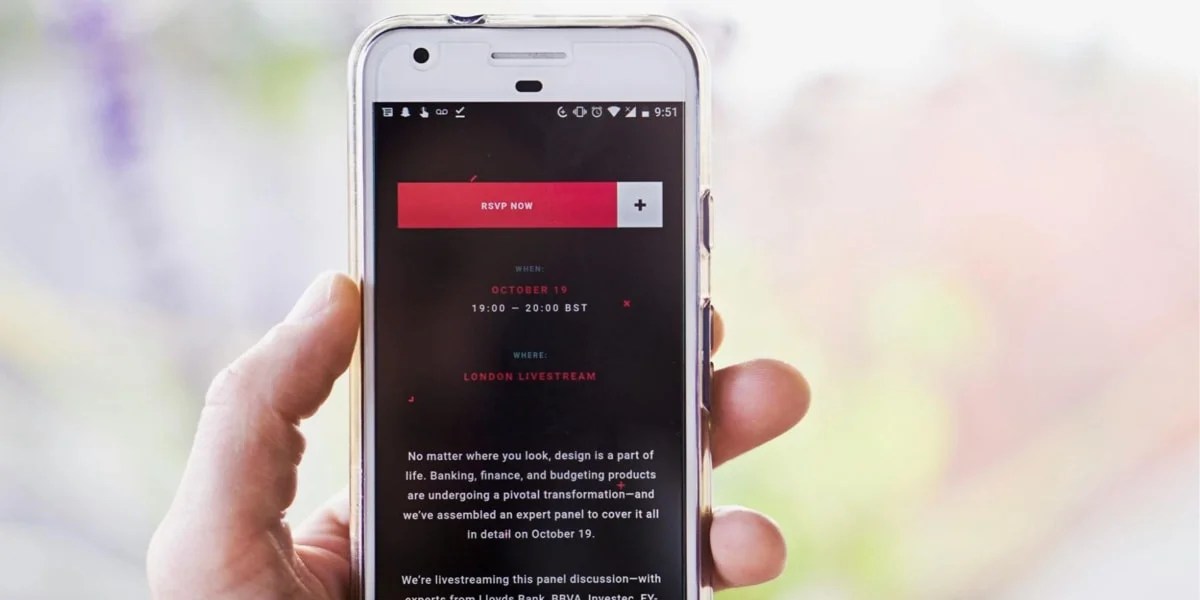
Upcoming events
Like product announcements, upcoming events deserve all the email promotion you can give them. As an ecommerce store, you might be participating in a local event, or something city-wide, regional, or national. Maybe you’re doing something in conjunction with another business. Maybe it’s a webinar, a presentation, a book release, or any number of other events.
Your ecommerce newsletter is a great place to promote this in the weeks and months leading up to the event. All it needs is a small mention that consistently shows up and says something a little different each time. You can create whole emails about the event, or just blurbs as part of an email that touches on other topics as well.
Relevant news
We talked about this earlier — not every email or topic in your ecommerce newsletter needs to sell something or be full of company updates. Relevance means entering into the conversation that’s happening in the minds of your subscribers and customers.
Suppose your ecommerce store sells home improvement products.

Well, what’s happening in the news that is relevant to homeowners? This could be:
- Mortgage interest rates
- Real estate prices
- Home affordability for the next generation
- Lawn and yard upkeep
- Maintenance and repair
- Scams
- Renting vs owning
- Over-55 communities
There are tons of news reports, videos, articles, blogs, and commentary about issues related to homeownership. Not all of these relate to your products, but they do relate to your audience’s lives.
All you have to do is summarize a relevant news article, put it in your newsletter, and include a link to read more. It doesn’t matter if you’re linking to a site that isn’t yours. You’re being helpful to your subscribers, and they will appreciate it. And if the news topic happens to relate to one of your email segments, then set up your email software so anyone who clicks on the link gets added to that segment.
Sharing news stories also positions your business as a reliable resource, a brand that’s knowledgeable and aware of what’s going on in the industry.

Customer reviews and feedback
Another great item to include in ecommerce newsletters is customer feedback, which can be presented as a quote or screenshot.
You can solicit customer feedback through polls and surveys, and then report on the results in a future newsletter. With surveys that allow for expanded response, you can quote actual submissions.
This is so good to do in part because it shows your audience that you listen to them and value their perspectives and needs.
Humor and personality
Humor is a great way to connect with an audience and humanize your brand.
Is there risk with humor? Yes, because not all humor connects with everyone. But not all of your newsletter content will connect with everyone. Why should the humor be any different?
While you don’t want to be offensive or make jokes at others’ expense, you also should know your brand identity well enough that you’ll have a good sense of how certain humor will land with your audience. If you’re uncertain on where to start, go with something small and good-natured, and let your brand voice evolve from there.
Product promotions
New products aren’t the only thing that matters. You have existing products that need regular promotion too. People forget. New subscribers and customers probably don’t know every product you sell, or every intended use of them.
You can promote products without offering any discounts. Just sell the product on its own merits. Focus on product benefits and outcomes, and feature positive reviews.
Seasonal content
Different holidays and seasonal events have more relevance to different ecommerce businesses.
For some, it might be Tax Day. For others, summer holidays, the start of the school year, Christmas, Halloween, Valentine’s Day, and many of the lesser-known holiday and seasonal events. Other countries will have their own holidays and seasons that everyone knows about.

And some seasonal content can be a place to use humor and entertainment. You may have seasonal products. There might be news stories related to this time of year. Many of the ecommerce newsletter ideas in this list can be combined with each other.
Interactive content
Interactivity turns a passive experience into an active one. This is another way to get readers engaged without directly selling them anything.
Surveys and polls are a great way to promote interaction. You can also ask people to visit your social media pages and leave comments. You can run contests and giveaways.

And not all your polls have to be serious. This is another way to inject entertainment and fun into your newsletter.
A clothing ecommerce store could run a poll about which outfit is your favorite, and include four photos. But you could make one of them a screenshot from a well-known animated film. That will generate some laughs and make it clear this is just for fun.
Loyalty program promotions
If you have a customer loyalty or VIP program, your newsletter is like free marketing for the recurring revenue these programs generate. This should be a consistent feature of your ecommerce newsletters. The more that people see it, the more it normalizes the idea of joining.
Referral and review requests
Yet another great use of your newsletter is to ask customers to refer other people to your ecommerce store. And give them incentives for doing this, like coupons and discounts, or even cash rewards if that works for your business. You could also give prizes or free gifts.
But again, by repeating this over and over, your subscribers will eventually start thinking of your brand and actually referring your ecommerce business to people they know or meet online.
Likewise, you can ask subscribers to leave reviews, rather than just hoping they do. Include links to the exact page where reviews can be left, whether on social media, Google, or other websites relevant to your niche.
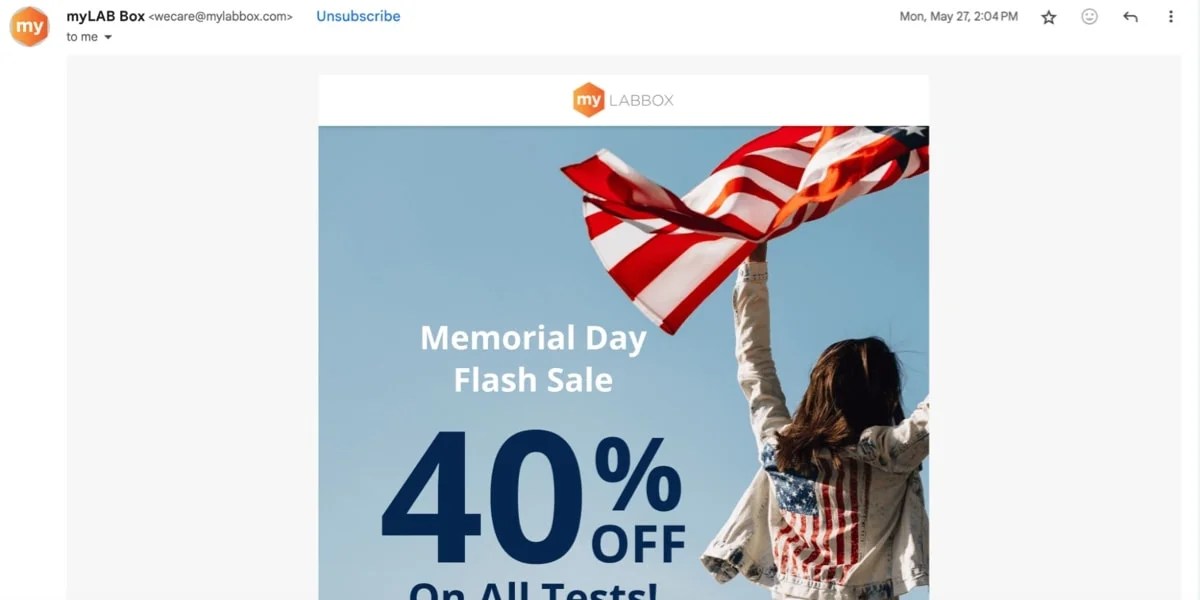
Sales offers and deals
Lastly, on occasion, you want to use your newsletter to offer special deals that are unique to your email subscribers. Go out of your way to say this — no one else gets this deal, it’s only for our loyal subscribers and customers.
Make it worth their while to remain subscribed and to keep opening your emails. You don’t want to run specials every week, but you want to do them enough that people feel appreciated for remaining loyal.
This is how you generate big recurring revenue and repeat customers through email — people who will stick with you for years. You can run specials like:
- Seasonal deals
- One-time offers
- Product bundles
- Coupon codes and discounts
- Free shipping
- Discounts that kick in above a minimum purchase price
- Free gift with purchase
- Product closeout sales
We recommend building your sales around events, whether it’s seasonality, holidays, or special days for your business. If sales are held too regularly, customers may come to expect frequent promotions and delay their purchases.
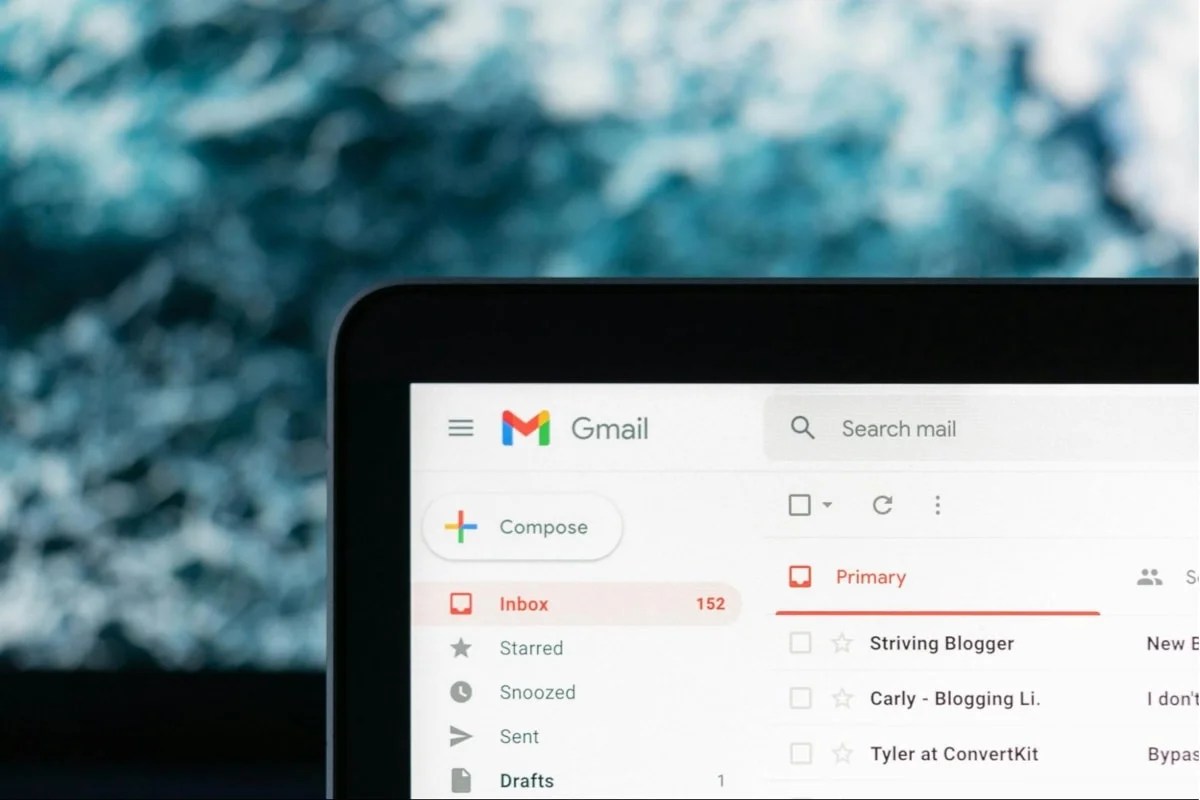
Think of creating a newsletter as a flexible engagement tool. The key difference with a newsletter is that it touches on more than one topic. Or, if it does only concern one topic, it goes into greater depth than just a couple sentences and a picture.
Some ecommerce newsletters will do a bit more selling and product promotion, but will also provide information or education. Other newsletters might feature something else, such as a news article, an upcoming event, an announcement, or a customer review.
But in general, most email newsletters provide multiple opportunities for different types of people in your audience to engage.
That’s why, as mentioned earlier, newsletters are one of your best tools for segmentation. You can use the format of presenting more than one topic to let different segments of your audience identify themselves based upon which links they click.
Here’s another way to think of it:
When people join your email list, they’re signing up to receive all your emails, not just your newsletter. You send newsletters, and you also send sales emails, survey emails, promotional emails, email automation like welcome emails, and various other types. You might include some of the same content that’s in your other emails in your newsletter, or it might all be different.
That’s up to you.

So far, you’ve seen why ecommerce newsletters are so important, and some of the best newsletter ideas to start with.
But how do we actually do this?
Here you’ll find ecommerce newsletter best practices that will ensure you get the most out of your newsletter marketing efforts.
1. Decide on an email frequency
You can always change this later, but you want to decide ahead of time how often to send your newsletter. Remember — you should also be sending other types of emails, so your newsletter is not the only thing your customers will receive.
So, you might start with creating two newsletters per month. This leaves time between issues to adapt to the process, and it also leaves room to send other types of emails without overwhelming your subscribers.
Whatever cadence you choose, make sure you can commit to it.

2. Create a publishing schedule
Next, decide when your ecommerce newsletter will be sent. Will it be on particular days of the week? What might make sense for your audience? For instance, a gardening supply ecommerce store might find the best day to send out their newsletter is Saturday morning, catching people before they head out into the yard.
Everyone who has a role in producing your newsletter needs to know the dates. We recommend planning newsletter content in six-month blocks, allowing your marketing team to research and produce content more efficiently.
3. Decide who will write
Does your marketing team have capacity to write the ecommerce newsletter in-house? Will you use contract workers on freelance sites? Or, will it be a crowd-sourced effort of some sort? You might have a graphic designer, along with two writers who specialize in different topics or types of content, plus yourself.
Make sure everyone involved knows their role and has the publishing schedule in hand.
4. Decide when to write
Next, when will the work get done? This is very important, because it ensures the newsletter will be published consistently.
If you’re a one-person marketing team, the most efficient way to produce a newsletter is to write them in batches, as mentioned above. If you’re doing two or three per month, write them all on the same day, upload the content to your email delivery platform, design them, and schedule them to go out. Scheduling a single day to write out content reduces anxiety around send dates and ensures that content doesn’t get repetitive.
If you’re working with a team, give them deadlines before the date the newsletter goes out, because you’ll need time to upload the content and design the email.
5. Have recurring features
With many feature and topic options to choose from, building consistency into a newsletter for one or two sections can help build readers’ anticipation or expectations for the next issue.
For instance, in the entertainment department, you might decide to do a ‘GIF of the month’ that your target audience will find amusing. They expect it. They look forward to it. And, you don’t have to scratch your head coming up with ideas every month, because you know that one idea is to have a funny GIF. Go look for funny GIFs, keep a file of them as you find them, and put one out each month.
Other recurring features might include customer reviews, deal of the month, the latest news, or something unique to your business.
And remember, not all of these have to be in every issue. If you’re sending two newsletters per month, you might have the funny GIF in one of them, and the deal of the month in the other.
This way, you’ll know what you’re looking for in advance of writing, and the writing process will be faster and easier.

6. Keep and use an idea file
As you get going on your ecommerce newsletter, you’ll find yourself coming up with more ideas than you can use. As with the GIF idea, you might decide one day to spend an hour just looking for funny GIFs. You might find ten of them. If you’re doing one per month, you’re set for the next ten months for GIFs.
Using this same approach, have a newsletter idea folder where you keep all the news articles, funny stories, anecdotes, famous quotes, customer successes, and other ideas you want to put in the newsletter. When customers begin seeing themselves in your publication, they may also begin sending you ideas.
7. Invite participation from employees
You can get more ideas, and more buy-in from your team, if you ask them to participate. Anecdotes, favorite products, and stories from their day to day will help humanize your business to your customers, making them feel like they know the folks behind the products they love.
8. Solicit user-generated content (UGC)
If customers and subscribers aren’t sending you newsletter ideas, you might be able to motivate them to do so. Make this an occasional request — have something you want to see in our newsletter? Send your idea here.
You could also turn it into a contest. Ask customers to tell you about their favorite product and why they like it, or a story about it. The best story wins a free gift, gift card, or some other perk.
If you can get good participation from this, not only have you learned a ton of valuable information about your target market and engaged your customers to make them feel important, but you also have a treasure trove of potential newsletter content.
You can ask for content of all sorts:
- Photos of them using your product
- Videos
- Funny or meaningful stories
- Favorite products
- Silly stuff they want everyone to see
9. Don’t overthink it
Email newsletters are, for the most part, one-time consumable content that either gets a response, or gets seen once and then deleted or discarded.
They’re mostly for fun and for engagement through helpful, relevant informational content. You will create a newsletter again next month. If you do happen to make an actual mistake serious enough to cause confusion or trouble, just send another email correcting the error, or wait until the next newsletter.
It’s not critical to make everything flawlessly perfect. It’s better to get it out there consistently than to fail to get it out because you’re just not sure if this is good enough.
To paraphrase Nike’s tagline, “Just send it”.
10. Repurpose other content
Lastly, you really, truly do not need to keep coming up with brand new content for every newsletter. Consider the other content you are hopefully producing now and then:
- Blogs
- Press releases
- Ebooks
- Guides, tips, and online resources
- Social media posts
- Videos
- Webinars
- Printed materials
- Product pages and other web pages
All of these assets can be repurposed for your ecommerce newsletter. Find a paragraph from your blog on a topic you want to feature in the next newsletter. Grab a section from a video you made and transcribe it to text, or edit the video and use only that section. Take a social media post from last year that you liked and use the same text again.
And if you produce your e-newsletter for long enough, you can even (don’t tell anyone this) take old newsletter content and re-run the exact same thing. Again, if it’s five years old, absolutely no one is going to remember it and say, “Didn’t you send us this five years ago? How dare you send the same thing again!”
No one will do that. If the content is relevant and engaging, then it’s relevant and engaging. It’s okay, and actually very smart, to re-use content that has already been used elsewhere in your marketing.

Here are a few more helpful tips for creating your ecommerce newsletter.
Don’t make them too short
It’s simply not true that people refuse to read long emails. People refuse to read emails that are boring and irrelevant.
As you’ve already seen in this article, emails that are helpful to an audience of people who opted in to receive those emails will get opened, read, and clicked.
Relevance is what matters, not email length.
Don’t make them too long
That said, this isn’t the place for 3000-word emails either. So don’t go on and on and on.
What makes longer emails work, especially email newsletters, is to make them easily consumable — especially on mobile devices. If your newsletter features more than one topic, you’re already doing this, because most readers will scroll through it and read the topics that interest them. Very few will read every topic, and that’s okay, because not all topics will be relevant to most people.
Just like a newspaper or magazine, you offer them a variety of content, and they read the stuff they want.
Not every issue needs to use the same format
It’s nice to see certain things each time, because the reader will recognize the familiarity and know what this is. So, having a logo for your newsletter, or a special name for it that appears at the top, and other definable visuals can be helpful to making this feel like a welcome part of the reader’s day.
But do you have to touch on five topics every time? Must you include a video, a GIF, a quote, and a poll every time? No. You can vary the format. You can adapt to the moment. You can emphasize something more in one issue than in others. Have two topics, then four, then three, then five. Or don’t.
These sorts of details don’t matter nearly as much as simply delivering enjoyable, helpful, and relevant content.

Learn how to write subject lines
Don’t make your subject lines something like “May newsletter!”
Only a loyal customer who opens everything you send will respond to that. For a newsletter with multiple topics, pick the most compelling option and come up with a subject line that touches on that topic. Then, it’s helpful to pick a different topic to feature in the pre-header. That way, every email gets two of its topics promoted visibly in the reader’s inbox.
You can research more about writing good subject lines, but if you want to sum it up in one sentence, it’s this:
Make them curious.
A good subject line introduces a thought, but doesn’t complete it. It makes us want to know more. It tells half the story. It’s the joke without the punchline.
There are a variety of ways to make people curious in a subject line or pre-header. Here are a few:
- Mention an odd detail
- Use words that demand more context like ‘this’ and ‘here’
- Use a word that causes a reaction
- Make reference to a celebrity or pop culture
- Use scarcity and deadlines — poll closes in less than 12 hours
- Make it feel important
Remember, you’ll also be sending out sales emails and other promotional emails. So your ecommerce newsletter should rarely feature a product or special deal in the subject line. Use other elements of your newsletter to motivate engagement.
If you’re struggling to get started, this is a great use case for AI. Describe the content in your email, your audience, and any other relevant details and ask it to come up with ten email subject line ideas. Adjust the prompt based on its responses and note any ones you love. While you may not use any subject line verbatim, it’s a great way to come up with clever ideas.
Include clear calls to action
Engagement does matter with ecommerce newsletters. You want these opened and clicked on. When you’re selling stuff, you want to make sales. You want polls taken, surveys responded to, articles read, and links clicked.
And you want to use your newsletter for segmentation, as discussed earlier.
So make sure that every link you include is clear about what it’s promising with its call to action language. If it’s a news article, use the common CTA of “read more”, if you want. Or, customize it a bit more for each article by adding a few words about the topic in the call to action.
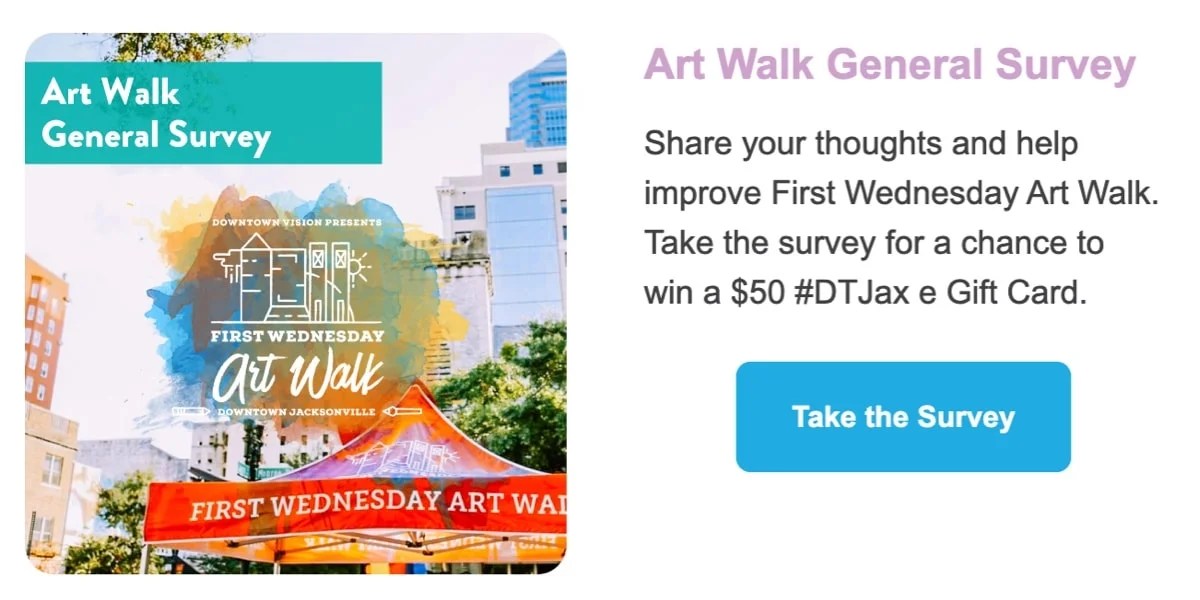
Here are some examples of clear call to action language:
- Take survey
- Share your thoughts
- Share this GIF on social media
- Secure your early bird special price
- Watch the full video
These are relatively broad. The more you can customize your CTA language to the topic, the better. If you’re segmenting, you want your market segments to see themselves in your call to action language.
Approach it like a customer service resource
This is a resource first, and a sales vehicle second. When you include sales and specials, make it clear these are being given only to the ecommerce newsletter subscribers. With that approach, it’s still a resource. It’s also a good deal.
Write your ecommerce newsletters with this mindset, and the tone will be spot on.
Balance images with text
You want a good balance of images and text. Only using images likely won’t communicate a clear message. Only using text will be boring and harder to engage with. Try to use a mix of both, and your readers will have an easier time engaging while being entertained and informed.
Sometimes, graphics and high quality images — even stock photos — help clarify something, or express an idea in a single image. Other times, they can add humor or color. Text is where explanations are given, details are made clear, and questions get answered.

Make it easy to read
There’s a lot to be said about this, but here are the best tips for making your ecommerce newsletter easy to engage with:
- Use small paragraphs, not large blocks of text
- Add subheadings for each topic’s section and wherever else they help
- Use bold, but not so much that it loses the effect
- Employ bullet points and numbered lists
- Use multiple calls to action for longer emails so they’re always easy to find
These techniques allow faster readers to skim quickly and get the point. And they allow slower skimmers to read more easily without getting lost.
This is why shorter emails aren’t automatically better. One 200-word email that’s all one paragraph is harder to read than a 500-word email using these techniques.
Be repetitive when appropriate
As mentioned earlier, hardly anyone will see and open all your emails. This is why it’s not just okay, but recommended, to repeat yourself, especially on important messages. Say it several times over several newsletters if you really want people to hear it.
For big offers, upcoming events and specials, polls and surveys where high participation matters, and other situations where you want a lot of engagement and response, don’t hesitate to repeat yourself over the course of several newsletters.
This also makes it easier to create more newsletters without staring at a blank page.
Don’t be shy about selling — just don’t overdo it
Finally, your ecommerce newsletter should generate revenue. The longer you do this, the more money it will generate, especially if you use it to promote things like loyalty programs and higher ticket items.
So don’t neglect using your newsletter to sell. Just don’t make this the primary focus of each issue.
For instance, you could offer gift cards in your newsletter. That’s selling, but really it’s a service because it’s helping your customers with a gift idea. Announcing new products is selling, but it’s also about getting people interested and curious about something they already care about, since they’re in your audience and fit in your brand identity.
For a newsletter with multiple topics, try to limit your sales to just one section of the newsletter.
To wrap this up, we want to show you a few examples of some of the best ecommerce newsletter tools. These email service providers will enable you to create and send consistent newsletters, monitor response and engagement, and increase customer loyalty.
To send commercial emails, you have to use a service like this. Otherwise, the emails will be marked as spam, and mailbox providers like Google and Yahoo will eventually stop your emails from reaching their recipients.
So to run a newsletter, you need a reputable email marketing platform that’s easy to use and that does everything you need it to do.
Here are the top platforms for sending emails that also have extensions for WooCommerce sites.
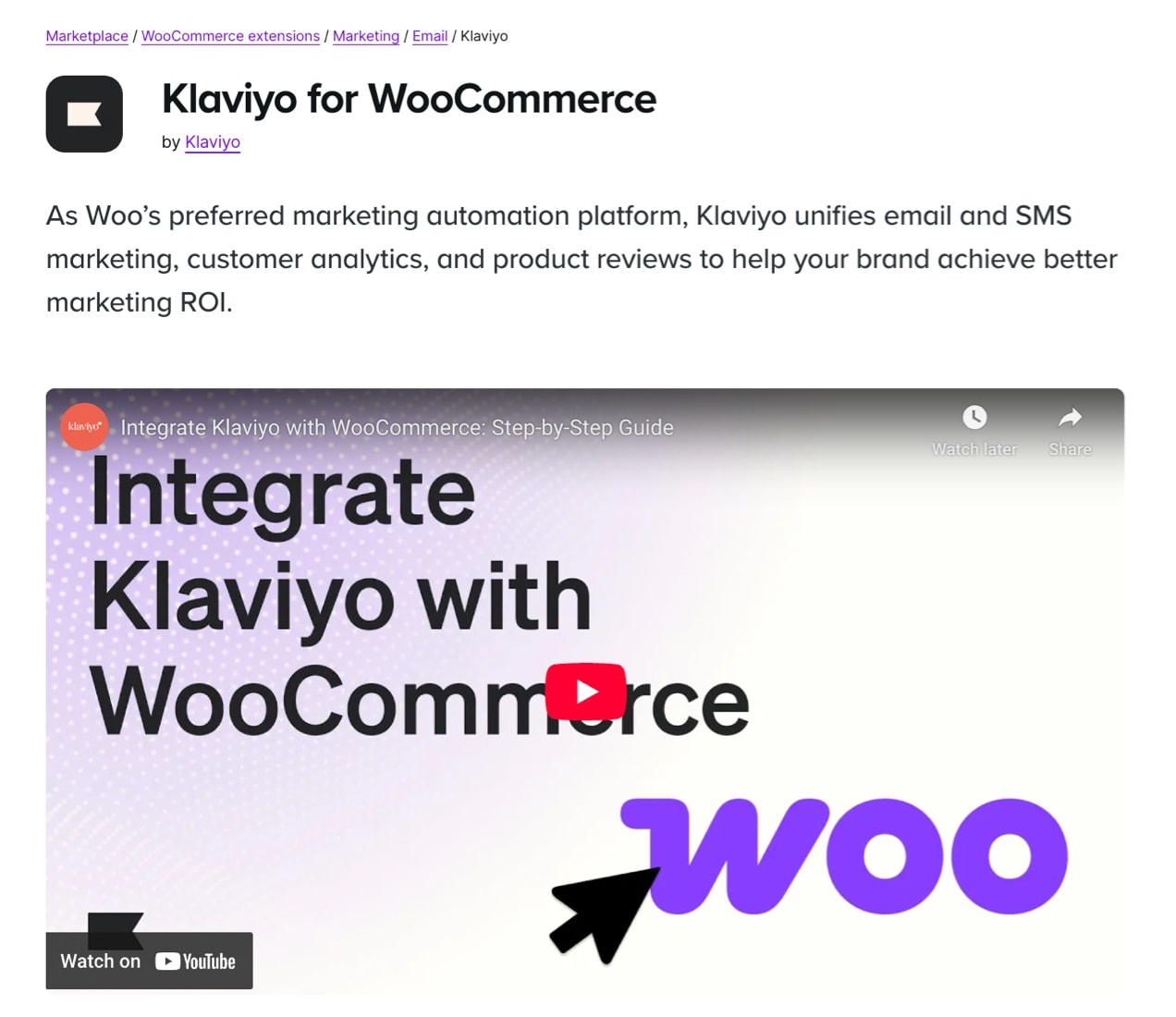
Klaviyo
Klaviyo is much more than just an email platform. It’s also a CRM, and can do many other things such as help you track response to paid online ads, and use mobile push notifications. And it also has a very robust email marketing service.
Find out why Klaviyo is Woo’s marketing automation platform of choice.
This is a great choice if you want a platform that has more advanced marketing automation tools than just email.
Key features of Klaviyo:
- Connections for multiple channels including email, SMS, mobile, and website
- The ability to create customer journeys that respond based on how customers engage with your content such as abandoned cart, price drops, and canceled orders
- A/B testing and customized triggers
- Content personalization, including dynamic coupons
Pros of Klaviyo:
- It has an easy-to-use drag and drop editor for blending design elements into a cohesive message.
- It includes conditional logic so customers see customized, relevant content.
- There’s automation for both email and SMS.
- It provides an extensive ability to create very specific segments.
- There’s customizable reporting dashboards and very strong analytics.
- Klaviyo has hundreds of integrations.
Cons of Klaviyo:
- Its plethora of features and automations may be more than a small business would need.
- As a more advanced platform, it’s more costly than other options.
Ease of use:
It’s pretty easy to use overall, but with so many features, it can take a while to get going. And advanced customization and customer journeys are naturally harder to work with, so getting those set up can involve a bit of a learning curve — or a dedicated email marketing hire
Pricing and plans:
Klaviyo offers a free plan, but it’s only good for 250 subscribers and 500 email sends — think of it like a free trial. You also get 150 SMS credits a month.
The Email plan starts at $45 per month and goes up from there. You can send 15,000 emails per month and take advantage of hundreds of integrations and generative AI.
The Email & SMS plan begins at $60 per month and includes 15,000 emails and 1250 SMS credits per month.
See the Klaviyo for WooCommerce extension
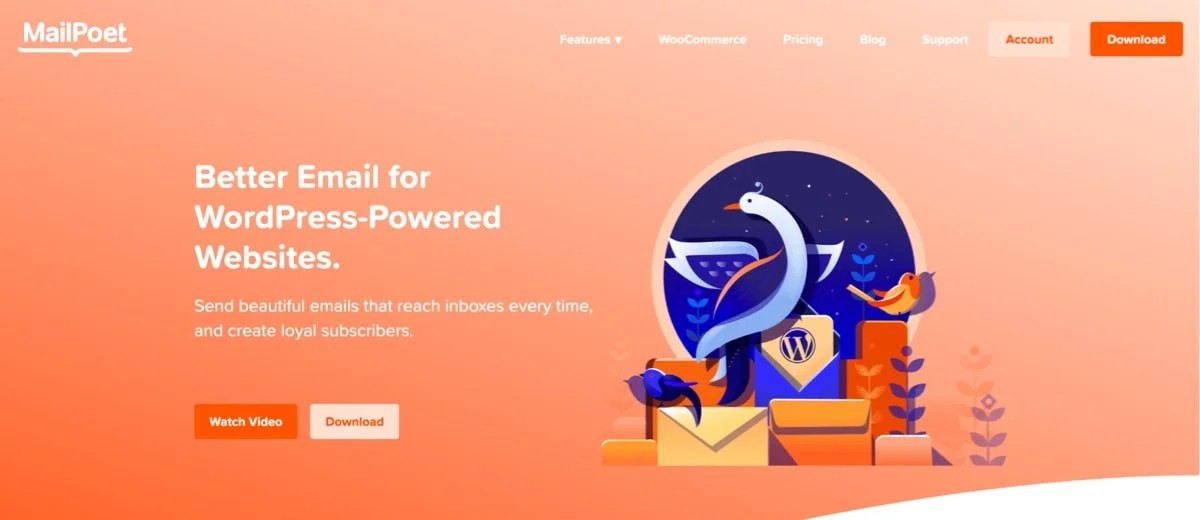
MailPoet
MailPoet is a great choice for new WooCommerce stores. It was created by and for WordPress and WooCommerce sites.
Key features of MailPoet:
- An easy-to-use interface for creating and sending newsletters — draft messages with pre-built branding elements directly from the WordPress dashboard!
- Numerous newsletter templates to choose from
- Email automation capabilities for abandoned carts, welcome emails, purchase emails, and more
- List segmentation tools
- Tracking for key metrics
- Attractive signup forms
Pros of MailPoet:
- It integrates seamlessly with WordPress and WooCommerce.
- It’s fast for busy entrepreneurs to get basic newsletters out.
- List management tools simplify subscriber opt-ins list segmentation.
Cons of MailPoet:
- MailPoet doesn’t integrate with tools outside of WordPress or WooCommerce.
- It can get expensive as you accrue 100,000+ subscribers.
Ease of use:
MailPoet is renowned for being one of the easiest email platforms to use. The average person can make this work even if they aren’t up to speed on all the latest tech.
Pricing and plans:
The starter plan is free up to 1000 subscribers, and offers the essentials for email marketing, including up to 5000 emails per month, forms, engagement statistics, and basic automation.
The business plan begins at $10 per month for 500 subscribers and increases from there. With this, you get unlimited email sends each month, segmentation, more robust automation, and priority support.
The agency plan begins at $30 per month for 500 subscribers and can use it on up to 50 different websites.
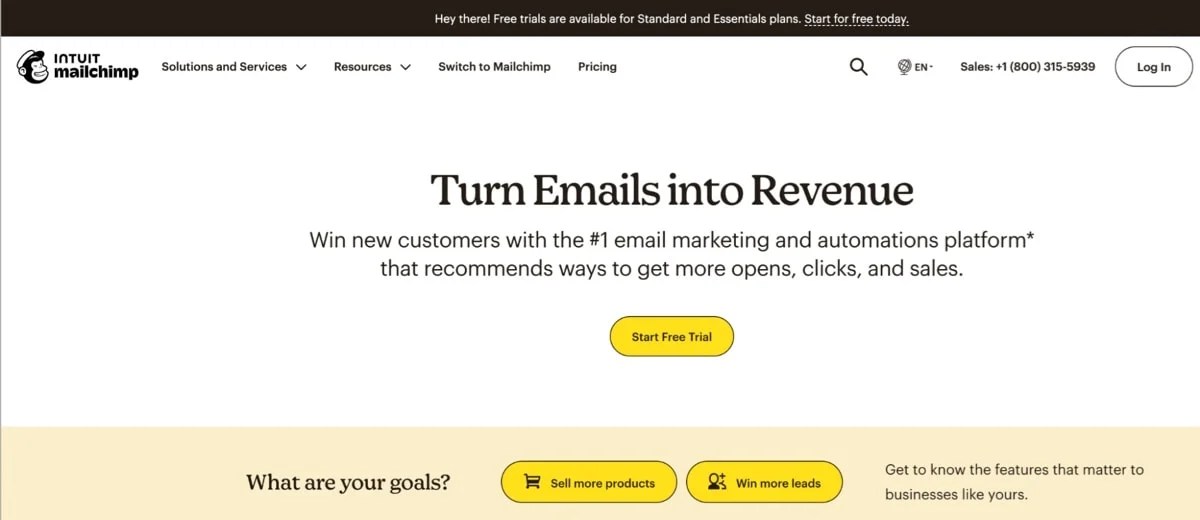
Mailchimp
Mailchimp is another very well-known email service provider, and has been around for decades. Here, you’ll also get great deliverability and an array of features ranging from simple to advanced. Since its purchase by Intuit, the free plan has reduced automation capabilities and the maximum number of contacts was reduced from 2000 to 500.
Key features of Mailchimp:
- Responsive triggers that allow for personalized communication
- Segmentation
- AI writing to help get started
- Email newsletter templates with pre-built design elements
- Analytics
- A/B and multivariate testing capabilities
Pros of Mailchimp:
- There are over 500 integrations available.
- It continues to add new features such as appointment scheduling.
- It uses a time-tested editor that’s easy to use.
- There are tons of email newsletter templates.
Cons of Mailchimp:
- It’s one of the higher priced options, especially as your list grows in size or if you exceed your email sending limit.
- MailChimp charges you for unsubscribed contacts.
- Working with lists and segments in Mailchimp can be frustrating.
- There’s not a ton of support options.
Ease of use:
It’s not as easy to use as some of the other options, but it can also do quite a bit more than some basic email service providers.
Pricing and plans:
The Free plan limits you to 500 contacts and 1000 email sends per month. This is to get comfortable with the interface and see if it works for you. You only get access to support for the first 30 days.
The Essentials plan begins at $13 per month for 500 contacts, and lets you have three users and send ten times as many emails as you have contacts, per month. You also get email and chat support.
The Standard plan starts at $20 per month and greatly increases your automation, segmentation, behavioral targeting, and dynamic content capabilities. Plus, you can send 12 times as many emails as you have contacts.
They also have a Premium plan, which is an enterprise version that does far more and comes with phone support, for $350 per month for 10,000 contacts.
See the Mailchimp for WooCommerce extension
You now know why it’s so important to regularly send an ecommerce newsletter. Plus, you’re equipped with ideas for content, how to plan and implement a marketing campaign, tips for getting the most from your efforts, and information about key extensions that work with WooCommerce.
All that’s left is to choose your desired platform and get moving: Choose your email marketing extension.
Nicola leads Marketing Operations at Woo, helping make the Klaviyo magic happen amongst other things! Outside of work she’s busy running around after a toddler and a Alaskan Klee Kai with a long list of crafting hobbies that never happen.
